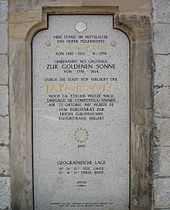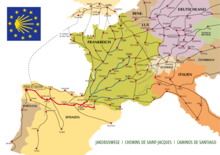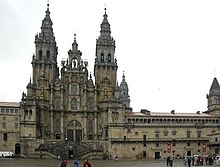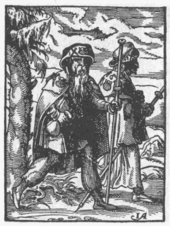Camino de Santiago
![]()
This article is a general introduction to the Way of St James; for the individual routes, see Routes of the Pilgrims of St James.
The Way of Saint James (Spanish: Camino de Santiago, Galician: Camiño de Santiago) is the name given to a number of pilgrimage routes through Europe, all of which have the alleged tomb of the Apostle James in Santiago de Compostela in Galicia (Spain) as their destination. First and foremost, this is understood to be the Camino Francés, that main high medieval route of northern Spain leading from the Pyrenees to the tomb of St James, linking the royal cities of Jaca, Pamplona, Estella, Burgos and León. This route, as it is still travelled today, originated in the first half of the 11th century.
A 12th-century pilgrimage guide contained in the Book of St James (Latin Liber Sancti Jacobi), the main source on the veneration of St James in the High Middle Ages, named four other routes for the French region that unite into one strand around the Pyrenees. Following the revival of the pilgrimage to Santiago de Compostela in the 1970s and 1980s, the main Spanish route was inscribed on the UNESCO World Heritage List in 1993. In 1998, the four French routes described in the Liber Sancti Jacobi also received this title. Before that, in 1987, the Council of Europe had already elevated the paths of the pilgrims of St James in Europe to the status of European Cultural Route and recommended their identification.

Memorial stone at the Marienkirche in Hof
.jpg)
Pilgrim monument We are on the way by Jörg Heydemann in Coesfeld

The scallop shell is the symbol for the Way of St. James

Ways of St. James in Europe

Cathedral of Santiago de Compostela, destination of the Way of St. James
General introduction
Name origin
The first mention of the Way of Saint James dates back to 1047, when a document from the Hospital of Arconada, in the province of Palencia, refers to the main northern Spanish road as "a route that has been followed since ancient times by pilgrims of Saint James and Saint Peter and Saint Paul". It is the first documentary reference to this road at all; it associates the route from the outset with the tomb of St James in Galicia. In common usage, the term Way of Saint James is also used for other historical routes of pilgrims of Saint James in Europe.
On the other hand, an international commission of experts set up in 1985 by the Council of Europe and attached to the government of the autonomous region of Galicia agreed on a nomenclature according to which only the main northern Spanish route would be called the Camino de Santiago (Way of Saint James). All other routes will be referred to as the "Way of Saint James". This is to express that for the Camino Francés the use by pilgrims of Santiago is assumed to be the main function, while the other routes were old roads that also, but not primarily, served pilgrims.
The pilgrimage route is also known as the Way of the Stars.
Destination of the Way of St. James
The burial place in Santiago de Compostela developed in the Middle Ages into the third main destination of Christian pilgrimage, alongside Rome and Jerusalem. In the course of the 12th century, the cathedral chapter of Santiago de Compostela knew how to integrate the redemptive theological teachings of early scholasticism into its pastoral work, even before Rome and other pilgrimage centres. A reconciling Christ was communicated to the people in a simple message that was understood by all, whose action would be granted to the people through the intercession of Saint James. Later, this pastoral concept was underpinned by the introduction of indulgences and Holy Years, following the example of Rome.

James the Elder by Gil de Siloe Metropolitan Museum of Art
History
Origin
After the Arab conquest of al-Andalus in the 8th century, the tradition that the apostle James the Elder had missioned on the IberianPeninsula, which had only been attested since the early 7th century, was taken up in Spain. The Christian successor realms of the vanished Visigothic empire were in need of an identifying figure. The discovery, prompted by a vision, of the alleged tomb of the Apostle in the extreme northwest of Spain in the period 818 to 834 under King Alfonso II of Asturias, and the creation of legends about the translation of the sacred body from the place of execution in Jerusalem to the end of the then known world, provided opportunities for the satisfaction of this need. The kings of Asturias and later of León made James their patron saint and trusted him especially as an aid to battle. At first, the area of worship remained limited to Cantabria. From about 930, after northern Spain was incorporated into the Christian dominion, there is evidence of isolated pilgrims from Aquitaine and the Lake Constance region.
In the Schaffhausen Book of Donors, a pilgrimage is attributed in 1070 to Count Eberhard VI of Nellenburg, the "founder of the monastery of All Saints at Schaffhausen: He was married to Ita, presumably from the family of the Counts of Kirchberg. With her, Eberhard undertook a pilgrimage to Santiago de Compostela."
High and late Middle Ages
Under the influence of the Reconquista as well as the monastic reform starting from the Abbey of Cluny and the development of a northern Spanish urban landscape along the Camino de Santiago, together with new developments in the Christian doctrine of salvation and redemption (soteriology), one of the greatest pilgrimage traditions of the Christian West developed in the 11th and 12th centuries. Around 1075/1078, construction began on a Romanesque cathedral, which became the seat of an archbishop in 1120. In the 15th century the pilgrimage site experienced a further boom with the introduction of special years of grace during which plenary indulgences were granted. Its catchment area reached as far as Scandinavia and east-central Europe. Although there is no evidence of specific pilgrimage numbers for either the High or Late Middle Ages, English pilgrimage ship licenses indicate for the 15th century that about fourteen times as many pilgrims came to Santiago de Compostela in the Holy Years as in normal years.
Modern Times
After a decline in pilgrimage in the early modern period, caused by a decline in the idea of pilgrimage, the Reformation and the Franco-Spanish War, a renewed upswing can be seen from the middle of the 17th century. This is clearly visible in a comprehensive building programme for the cathedral, which was initiated in 1657 by the canon José de Vega y Verdugo and concluded in 1769 with the completion of a new north façade. After Napoleon's campaign on the Iberian Peninsula, a sweeping wave of secularization almost completely dissolved the charitable infrastructure of the northern Spanish Way of St. James and led to a significant decline in pilgrim numbers, although pilgrim traffic on the Way never came to a complete standstill.
The rediscovery of the bones, hidden in 1589 in fear of an English naval attack, in 1879 brought about a turning point, especially after Pope Leo XIII recognized the authenticity of the rediscovered relics in 1884.
At the end of the 1920s, the American Walter Muir began to transcribe the Liber Sancti Jacobi (Codex Calixtinus); after the Spanish Civil War, it was published in 1944 and the Way of Saint James was reopened as a zone of peace. Before the end of the Civil War, Francisco Franco made the request to make Santiago once again the patron saint of Spain. From then on, Franco and the nationalists used the saint to equate themselves with the "preserver of Spanish Catholic identity". The image of the Matamoros (Moorish slayer) became a symbol of his fascist-nationalist politics.
In 1937, General Franco declared the feast of St. James a Spanish national holiday, a political instrumentalisation in a nationalist sense, which was overcome by the international interest in the pilgrimage after 1945. After the Second World War, which left Europe deeply wounded, people found what they were looking for in the Way of Saint James: "The Way of Saint James, with its roots in Christian Europe, created the ideal way to overcome political differences and bring a continent together more through the sound of trampling feet than through warfare."
In the 1950s and 1960s, associations of "Friends of the Way of St. James" were formed in Spain and France, and there was also continued political interest in the scientific reappraisal and tourist development. In 1950, the first Society of St. James was founded in Paris with the claim to work scientifically.
In the Holy Compostelan Year of 1954, some youth pilgrimages took place - but it was mainly Franco supporters who set out on horseback to venerate the patron saint of Spain.
upswing in modern times
Since the 1970s, pilgrimage on the Way of Saint James has experienced a great upsurge. In 1982 and 1989, Pope John Paul II visited Santiago de Compostela and, as part of a great "celebration of Europe", called on the old continent to revive its roots. In 1987, the Council of Europe declared the route to be the first European cultural route. At that time, just over 3,000 pilgrims were registered each year; in 2003, there were over 74,000 from all countries of the world. In 2004, the Holy Year of Compostela, there were 179,932 pilgrims who walked or rode on horseback for at least the last 100 kilometres of the Way, or cycled the last 200 kilometres. This is recorded on a pilgrim's card with stamps from individual stops and entitles them to use the low-cost pilgrim hostels and wear the appropriate badges. In Santiago, pilgrims receive a certificate, the Compostela.
The upswing took the following course in the past decades:
| Year | Pilgrim | Year | Pilgrim | Year | Pilgrim | Year | Pilgrim | Year | Pilgrim | Year | Pilgrim | |
| 1970 | 68 | 1980 | 209 | 1990 | 4.918 | 2000 | 55.0043) | 2010 | 272.1351) | 2020 | 53.9057) | |
| 1971 | 4511) | 1981 | 299 | 1991 | 7.274 | 2001 | 61.418 | 2011 | 183.3664) | 2021 | 1) | |
| 1972 | 67 | 1982 | 1.8681) | 1992 | 9.764 | 2002 | 68.952 | 2012 | 192.488 | 2022 | 8) | |
| 1973 | 37 | 1983 | 146 | 1993 | 99.4361) | 2003 | 74.614 | 2013 | 215.880 | 2023 | ||
| 1974 | 108 | 1984 | 423 | 1994 | 15.863 | 2004 | 179.9441) | 2014 | 237.8865) | 2024 | ||
| 1975 | 74 | 1985 | 690 | 1995 | 19.821 | 2005 | 93.924 | 2015 | 262.459 | 2025 | ||
| 1976 | 2431) | 1986 | 1.801 | 1996 | 23.218 | 2006 | 100.377 | 2016 | 277.8546) | 2026 | ||
| 1977 | 31 | 1987 | 2.905 | 1997 | 25.179 | 2007 | 114.026 | 2017 | 301.036 | 2027 | 1) | |
| 1978 | 13 | 1988 | 3.501 | 1998 | 30.126 | 2008 | 125.141 | 2018 | 327.378 | 2028 | ||
| 1979 | 231 | 1989 | 5.7602) | 1999 | 154.6131) | 2009 | 145.877 | 2019 | 347.538 | 2029 | ||
| 1) Holy Compostelan Year, celebrated when the feast day of St. James the Elder - July 25 - falls on a Sunday. 2) IV. World Youth Day in Santiago de Compostela (Source: Statistics of the Cathedral Chapter of the Cathedral of Santiago de Compostela) | ||||||||||||
In 2017, people from 177 countries visited the Way of Saint James. Almost half of the visitors were Spanish, others came from Germany, Italy, the USA, France or Portugal. In 2020, due to the COVID 19 pandemic, the number of pilgrimage certificates issued plummeted by 84.49 percent compared to the previous year. The percentage of non-Spanish pilgrims dropped from about 55 to about 25 percent compared to 2019.
Development of the road network since 1980
An overview of the signposted pilgrimage routes to Santiago de Compostela can be found in the article Ways of the Pilgrims of St James.
In 1980, the Spanish priest Elías Valiña Sampedro began to mark the Camino Francés in northern Spain with yellow arrows and to ensure the development of a hostel network, having previously presented a doctoral thesis on the historical and canonical foundations of the Way. At the same time, renowned scientific congresses and exhibitions (including Munich 1984, Ghent 1985) focused on the European dimensions of the pilgrimage to Santiago de Compostela. The growing popularity of the Way prompted the Council of Europe to devote itself to the subject as well. Its Declaration of Santiago de Compostela (23 October 1987) elevated the paths of the St James pilgrims in Europe to the status of the first European Cultural Route (Council of Europe Cultural Route). Authorities, associations and individuals were asked to "mark and identify the pilgrimage routes to Santiago throughout Europe". Two international congresses organised by the Council of Europe in October 1988 with the German St James Society at Schney Castle near Lichtenfels and in September 1989 with the Centro Italiano di Studi Compostellani in Viterbo provided a binding basis for the designation of the routes. Thus, the final declaration of the congress at Schney Castle "emphatically stressed the need for a strictly scientific identification of the historical routes to Santiago, namely on this side of the Pyrenees, as well as of the other traces of this cult, based on written and iconographic documents as well as on research in the field". The declaration stressed that this was an "indispensable condition for their revitalisation".
During the congress at Schney Castle, the staff of the Inventory of Historic Routes in Switzerland (IVS) were already able to present extensive and professionally sound route projects for Switzerland. The Swabian Way from Constance to Einsiedeln and its continuation to the Rhone were among the first signposted routes for the pilgrims of St James after the "Camino Francés" and the Via Podiensis.
France
In France, the restoration of the road network is based on a complex system of classifications introduced by the Centre d'études compostellanes in Paris in the 1980s.
- Only the four main routes, Via Turonensis, Via Lemovicensis, Via Podiensis and Via Tolosana, which were mentioned in the 12th century in the pilgrims' guide (5th book) of the Liber Sancti Jacobi, are considered to be Chemins de Saint-Jacques.
- A second category is formed by the Itinéraires. These are additional routes for which historical pilgrimage guides or pilgrimage reports are available.
- Finally, there is the third category of cheminements. These are routes that have been proven to be the routes of the pilgrims of Santiago through documents such as customs books or lists of passers-by from hospices and other evidence.
The main trails have been designated as GR long-distance trails in collaboration with the Fédération française de la randonnée pédestre.
Germany
In Germany, the designation of paths did not begin until 1992, when the Protestant pastor Paul Geißendörfer, together with six St. James parishes, realized a pilgrimage path from Nuremberg to Rothenburg ob der Tauber. This path was extended until 1995 in cooperation with the Franconian Albverein and the Oberpfälzer Waldverein to form the Franconian Way of St James, which leads from Tillyschanz via Schwandorf, Nuremberg, Heilsbronn to Rothenburg ob der Tauber. The pilgrimage route from Nuremberg via Ulm to Constance is regarded as a reference project for a historically accurate route in accordance with the provisions of the Council of Europe. It was developed between 1995 and 1999 on the basis of two reports by late medieval pilgrims of St James, closely following the course of an imperial road. Since 1999, the Regional Associations of the Rhineland and Westphalia-Lippe have been working on the project Wege der Jakobspilger im Rheinland und in Westfalen.
In May 2003 the Munich Way of St. James was inaugurated, leading from the Angerkloster on Jakobsplatz in Munich to Bregenz and Lake Constance, where it joins the Swiss Way of St. James. In the German states that were added in 1990, the Ecumenical Pilgrims' Way was created in 2003 as the first route along the historic course of the Via Regia from Görlitz to Vacha. Thereafter, from 2009 to 2013, the Saxon Way of St. James in the course of the Franconian Road or Via Imperii between Bautzen or Königsbrück and Hof, connected with the Way of St. James Vogtland and the Way of St. James Silberberg, was designated again.
Since 2005, the routes of the pilgrims of St. James in Northern Germany have been worked out with the two main routes Via Baltica from Usedom to Osnabrück and Via Jutlandica from Frederikshavn to Glückstadt, the latter in Danish-German cooperation.
Four paths of the pilgrims of St. James run through Hesse. One follows the course of the historic long-distance trade route from Leipzig to Frankfurt am Main (Des Reiches Straße). Another leads from Eisenach together with the Elisabethpfad via Marburg and Siegen to Cologne. The third trail begins in Wetzlar and leads as the so-called Lahn Camino via Koblenz to Bingen on the Rhine. Another Elisabeth Trail leads from Frankfurt via Wetzlar to Marburg.
Another branch in Rhineland-Palatinate leads as a continuation from Frankfurt/Main via Mainz and then on the historic Ausoniusweg via Bingen to Trier.
In the meantime, the Jakobswege in Germany form an extensive network of routes, consisting of over 30 sections.
Austria
The main branch of the Way of St. James in Austria can largely be traced back to a private initiative of the author Peter Lindenthal, who in 1997 began to develop an east-west route from Wolfsthal to Feldkirch through research in the field on the basis of the medieval Way of St. James and sporadically mark it with wooden panels. In the meantime, several sections, e.g. the Way of St. James Weinviertel, the Way of St. James West Styria, the Way of St. James Göttweig-Melk, the Way of St. James in Upper Austria and Salzburg, the Way of St. James Tyrol and the subsequent Way of St. James Landeck-Einsiedeln have been signposted as part of Leader+ projects, by tourism organisations and partly on their own initiative.
The 38.4 km long section of the route through Vienna, from St. James' Church in Schwechat via the Albern harbour to Purkersdorf, was signposted and opened with a festival and walk on 25 July 2016.
Poland
In Poland, paths of St. James pilgrims have been created since 2005, which connect to the German network of paths in Görlitz, Frankfurt (Oder) and Kamminke. Thus, the ecumenical pilgrimage route in the course of the Via Regia was extended to the border with Ukraine. A path leading from Olsztyn (Allenstein) via Görlitz and Prague was also marked. There are also several local and regional feeder routes to the main pilgrimage routes.
Switzerland
Several branches of the Way of St. James run through Switzerland. The best known is the Swabian Way from Constance to the pilgrimage site of Einsiedeln. The trail is part of SwitzerlandMobility's national hiking route No. 4 ViaJacobi, which runs from Rorschach via St. Gallen and Einsiedeln to Geneva.
The following connecting routes lead into the ViaJacobi: from Blumberg via Schaffhausen and from Basel to Romont. SwitzerlandMobility regional route No. 43 Jakobsweg Graubünden, coming from Val Müstair, joins the Via Jacobi at Amsteg. The Appenzell Way, regional route no. 44, coming from Rankweil in Vorarlberg joins the Via Jacobi at St. Peterzell.
Luxembourg
Pilgrims from northern Europe also crossed what is now Luxembourg in the Middle Ages. Some finds, such as a scallop shell in a tomb in Grevenmacher, testify to this. Coming from Aachen and Trier, the medieval pilgrims probably followed the old Roman routes in the direction of Arlon, Reims and Metz, in order to reach the historic pilgrimage routes Via Podiensis (starting from Le-Puy-en-Velay), Via Turonensis (Orléans), Via Lemovicensis (Vézelay). The route passes by where the cult of St James was cultivated in Luxembourg. Examples are Münschecker, Roodt-sur-Syre and the Jakobsberg "Jokesbierg" near Bech. Well-known pilgrimage sites such as the tomb of St. Willibrordus in Echternach or the places of pilgrimage that only came into being in modern times, such as Luxembourg Cathedral, were also included in the route.
_8310-011.jpg)
Way of St. James in Luxembourg at the Boulevard Franklin Delano Roosevelt, Departure to the whipping post

Way of St. James between Trier and Metz with the church of St. James near Fisch

Signpost at the Constance Cathedral

The scallop shell and the yellow arrow are the typical orientation aids along the way

Pilgrim of St. James, depiction from 1568
Search within the encyclopedia